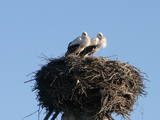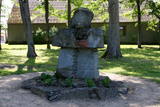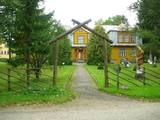| Нo | Название | Описание |
|---|---|---|
|
Знакомство с Сигулдой можно начать с посещения развалин Сигулдского замка. Строительство замка было начато орденом Меченосцев в 1207 г., а в 1236 г. его перестроили для нужд Ливонского ордена. Сигулдский замок серьезно пострадал во время воин второй половины XVI и начала XVII веков. Во время Северной войны замок был сожжен и больше не восстанавливался. Сегодня можно осмотреть юго-западный корпус здания конвента замка и башню главных ворот, за которой находятся внутренний передний двор замка с эстрадой под открытым небом, откуда приоткрывается прекрасный вид на древнюю долину Гауи. В настоящее время ведутся работы по реконструкции развалин замка. Строительство расположенного на юге Нового Сигулдского замка (владелец - князь Кропоткин) происходило в период с 1878 по 1881 гг. С 1923 по 1940 гг. в здании размещался Дворец писателей, а в советские годы - санаторий кардиологии. С 2003 г. здесь находится дума Сигулдского края. В комплексе господской усадьбы сохранилось деревянное жилое здание (середина XIX века), дом семьи Кропоткина, клеть (XVIII –XIX вв.), дом садовника (XIX в.) и каменный забор (XIX в.). Если от Нового замка отправимся в северо-восточном направлении, то примерно через 2 км спустимся к оврагу Вейупите. Здесь расположена небольшая (3,6 м), но высокая пещера Петра (6,1 м) и глубокий овраг Пучу (Сов) с Краукльупите. В месте соприкосновения оврагов обеих рек возвышается городище Сатезелес (площадка 90 x 75 м), где вначале XIII в. находился дубовый замок вождя (старшего) ливов Дабрелиса. Неподалеку находится ущелье Крауклю (Ворона) – боковой овраг левого берега Вейупите с песчаником высотой 11 м и пещера Крауклю (Ворона) глубиной 5,2 м. В месте соприкосновения оврага Вейупите и древней долины Гауи стоит гора Парадизес (Райская) или Глезнотаю (Художников) - живописнейшее место, которое удостаивалось кисти художников и вниманию фотографов с давних времен! До горы Парадизес можно доехать на электромобиле. В западной части Сигулды можно посетить Панорамное колесо (работает в летний период) и Канатную дорогу (трамвайчик) - единственное в странах Балтии транспортное средство подобного рода (построена в 1969 г.). Несущий трос канатной дороги, протяженностью 1060 м, без опор, соединяет берега древней долины Гауи между Сигулдой и Кримулдой примерно на высоте 40 м над Гауей. Отсюда открываются великолепнейшие виды! По юго-западной части Сигулды можно дойти до громадного обрыва Бейтес, который раскалывает ущелье глубокого ручья. В западной части ущелья находится Кейзерскатс, расположенный примерно на высоте 67 м над уровнем Гауи, с открывающимся прекрасным видом на Кримулду и Турайдский замок. Смотровую площадку здесь обустроили еще в 1862 г., когда в Сигулде гостил Российский самодержец Александр II. В восточной части оврага находится высеченный из дерева Кейзаркреслс (Царский трон). |
||
|
Межа мая – здание, построенное в 1933 г.,
является одним из самых ярких строений
национального романтизма в Латвии.
Первоначально здание служило в качестве
широко известного в округе ресторана "Яутрайс
одс" ("Веселый комар"). После Второй мировой
войны в здании разместился детский санаторий
"Межа мая" (Лесной дом). С 1997 г. с
созданием Кемерского национального парка,
"Межа мая" стало зданием администрации и
одновременно современным центром для
посетителей, а также местом проведения
различных экологопросветительских
мероприятий.
|
||
|
Кафе «Кивишкрогс» расположено между Талси и Лайдзи, на обочине шоссе Талси – Упесграва (Р127). Латышская кухня: Холодный на кефире и холодный свекольный суп, селедочный салат, жареные свиные ребрышки, жареная треска или камбала, картофельные и тонкие блинчики. Особое блюдо: «Хрустящий поросенок». |
||
|
This lovely territory includes the hillocks of Embūte, which are in the ancient Embūte valley. The aim of establishing the park was to protect the landscape, biotopes and species of the region. An ecological tourism trail has been established in the valley, as has a forest trail through the nature park (accessibly only in the company of a guide). Visitors will learn about the hillocks and ravines left behind by the Ice Age. The ravines and the forests along their sides are protected biotopes. There are also important natural and cultural monuments, including the Embūte castle hill and the ruins of a baronial estate, castle and church. Other points of interest include the death place of the Courlandian warrior Indulis, the Joda dam, meadows, a viewing tower, etc. Three unmarked bicycle trails are in the area. |
||
|
Valkas novadā esošā saimniecība "Kurģi" ir vieta, kur braukt atpūsties gan ģimenēm, gan draugiem. Viesiem tiek piedāvātas izjādes zirga, ponija mugurā, pajūgs gan ģimenēm, gan kāzām. |
||
|
Находится в центре Джуксте. Установленный в 1990 году памятник через год был взорван, нынешний создан из его остатков. Памятник посвящен воинам 19-ой дивизии Латышского легиона, павшим в Рождественских боях 1944 года. |
||
|
"Mākoņmalas" is located in the middle of the forest, in silence. A magical place where you can enjoy SPA procedures and sauna rituals, gain knowledge in magical and non-traditional practices, as well as be alone with nature, improve health, enjoy a "short vacation for the hurried and busy". In "Cloud Edges" you will receive a restart for both body and soul. After the procedures, it is possible to enjoy a deep night's sleep in our home and taste the early breakfast on the terrace, watching the morning rituals of wild animals and the beauty of nature. You can enjoy the morning with a stick or a regular morning walk through the forest to meet deer and other forest dwellers. |
||
|
Калевипоэг- герой Эстонского национального эпоса, и именно Йыгевамаа тесно связано с историями о нем. Здесь меч Калевипоэга в реке Кяапа, места отдыха, камни, родники, болота, вспаханные борозды, следы лошади и т. д. В музее Калевипоэга 12 тематических комнат, где представлены связанные с ним материалы и Эстонское культурное наследие. Перед зданием музея- заповедный сад и 17 деревянных скульптур героев эпоса. |
||
|
Число голов – около 50, они все пасутся на улице, поэтому осмотреть их можно в любое время. При возможности посетители могут попробовать мясо породы Хайленд. Также посетители могут осмотреть жямайтукасов и покататься на них. Экскурсии больше рекомендованы для взрослых лиц. |
||
|
Молочное предприятие производит сыры по старинным латвийским рецептам. Как сто и более лет назад, сыры делают вручную. Продукции присвоен знак качества «Зеленая ложечка». Свежий сыр можно коптить. Организует экскурсии, во время которых можно ознакомиться с предприятием. Принимает заказы и доставляет готовую продукцию. |
||
|
Строительство замка в Сигулде было начато орденом Меченосцев в 1207 году, а в 1236 году его переоборудовали для нужд Ливонского ордена. Замок в Сигулде сильно пострадал в войнах второй половины 16 и началa 17 века. Во время Северной войны его сжигают и более не восстанавливают. На сегодняшний день для осмотра доступно здание конвента юго-западного корпуса замка и башня главных ворот, за которой находится внутренний форбург с эстрадой под открытым небом, открывающей великолепный вид на долину реки Гауя. Строительство Нового замка Сигулды, находящегося на юге (владелец - князь Кропоткин), проводилось в период с 1878 - 1881 годa. B 1923 - 1940 годы в здании располагался Дом писателя, а во время СССР - кардиологический санаторий. С 2003 года здесь находится Сигулдская краевая дума. В комплексе имения сохранилось деревянное жилое здание (середина 19 века), в котором находился дом семьи Кропоткина, амбар (конец 18 – начало 19 века), дом садовника (19 век) и каменная ограда (19 век). Если от Нового замка мы поедем в северо-восточном направлении, менее чем через 2 км мы подъедем к оврагу Вейупите (речка Ветров). Здесь находится неглубокая (3,6 м), но высокая (6,1 м) пещера Святого Петра и глубокий Совий овраг с Крауклюпите (речка Ворона). На месте соприкосновения двух оврагов возвышается городище Сатезеле (площадка 90 × 75 м), где в начале 13 века находился дубовый замок вождя земли ливов - Дабреля. Недалеко находится ущелье Воронов - боковая ложбина левого берега Вейупите со стенами из песчаника высотой 11 метров и пещера Ворона глубиной 5,2 метра. На месте соприкосновения оврага Вейупите и русла реки Гауя возвышается Райская гора (Художников) – очень живописный ландшафт, вдохновлявший художников еще с древних времен. В западной части Сигулды можно посетить Колесо обозрения (работает в летнее время) и канатную дорогу (трамвай) - единственное транспортное средство подобного типа в странах Балтии (построена в 1969 году). Несущий трос канатной дороги тянется без поддержек 1060 метров и соединяет берега долины реки Гауя между Сигулдой и Кримулдой на высоте около 40 м над рекой. В юго-западной части Сигулды можно посетить утес Бейте, пересеченный глубоким оврагом ручья. На западной стороне оврага находится Государев вид, который находится на высоте 67 метров над уровнем реки Гауя с великолепным видом на Кримулду и Турайдский замок. Смотровую площадку здесь обустроили в 1862 году, когда Сигулду посетил российский царь Александр II. На восточной стороне оврага расположен выполненный из дерева Трон государя. На месте, где правый берег русла реки Гауя пересекает множество глубоких оврагов небольших ручейков, расположился Турайдский музей-заповедник с имеющими большую ценность для всей Балтии памятниками, история которых тянется на 1000 лет назад. Среди них следует упомянуть Турайдское имение (21 здание), могила Турайдской Розы, Турайдская Лютеранская церковь (одна из старейших деревянных церквей Латвии (1750 год)) и Турайдский замок. На располагающейся рядом горе Дайн организуются различные тематические мероприятия. |
||
|
Pie ceļa, kas no Bernātu ciema centra ved uz jūru, redzamas augstas ar mežu apaugušas kāpas. Uz vienas kāpas (ir norāde) novietots piemiņas akmens ar pirmā Latvijas Valsts prezidenta Jāņa Čakstes 1924. g. teiktiem vārdiem: “Te jābūt kūrortam.” Atrodas Bernātu dabas parkā. |
||
|
Сохранилось в рабочем состоянии выпущенное в XIX веке на латвийском машинном заводе «Шуберт Рудзитис & т-щи» чесальное и прядильное оборудование, произведенная в Германии уникальная прядильная машина и мельница с жерновыми поставами. На представленном 100-летнем старинном устройстве по переработке шерсти изготавливаются одеяла и подушки, наполненные набивкой из овечьей шерсти (ручная работа), и сувениры, которые можно заказать и купить. Предлагаются экскурсии, пекут хлеб. Латышская кухня: Маринованная салака с овощами, букстиньпутра, картофельное пюре по-Видземски (с жаренным луком), блинчики с вареньем из латвийских ягод и меда, хлеб собственного приготовления. Особое блюдо: Крендели из заварного теста и хозяйский суп из шести видов рыбы. |
||
|
Atrodas Vecpiebalgas dienvidaustrumdaļā aiz baznīcas. 1340. - 1365. g. Rīgas arhibīskaps šeit uzcēla pili - cietoksni, ko apjoza aizsarggrāvji (atliekas redzamas arī mūsdienās). Pils ziemeļu pusē atradās priekštilta nocietinājumi, bet austrumdaļā - pils galvenā ieeja un tornis. Pili postīja 1577. g., bet pilnībā sagrāva 18. gs. |
||
|
Saimniecība "Baltiņi" atrodas Auces novadā un nodarbojas ar lopkopību un lauksaimniecību. Viesiem ir iespēja redzēt un izzināt piena ražošanas procesu, kā arī iepazīt saimniecības dzīvniekus. Saimnieki piedāvā apskatīt padomju laiku auto kolekciju, pieejama arī suvenīru un trauku kolekcija ar govs motīviem. |
||
|
The biggest sea island in Estonia. In translation - "Land of The Islands". A bridge, where cyclists can drive connects Saaremaa island to Muhu island . |
||
|
The Great Ķemeri Bog Boardwalk is located in Ķemeri National Park. The national park covers an area of 38,165 hectares. The Great Ķemeri Bog Boardwalk immerses visitors in the world of moss, small pine trees, deep pools, tiny dark lakes and the smell of wild rosemary. An astute visitor will notice the carnivorous sundew plant and a variety of birds – wood sandpipers, white wagtails and tree pipits – and will also be able to hear cranes further away. Those who prefer shorter strolls can take the small boardwalk loop (approx. 1.4 km), while those who choose the great loop (approx. 3.4 km) will be rewarded with the opportunity to climb to a viewing platform that offers a magnificent view of the bog from above. The Great Ķemeri Bog Boardwalk has become a popular place for landscape and wildlife photographers. The whole trail is laid to wooden boardwalk and therefore is fully accessible and can be walked without a professional guide. |
||
|
По всей своей протяженности тропа выстлана деревянными мостками. Она извивается то вверх, то вниз, вдоль крутых берегов низовья Пилсупе и приоткрывает красивые виды на три белых песчаных обнажения (самое крупное из них и есть Белая дюна). Окрестный дюнный массив образовался в период Литоринского моря нескольких тысяч лет тому назад. В окрестностях тропы найдены свидетельства поселения эпохи каменного века. Необходимое время для осмотра тропы примерно полчаса. |
||
|
SIA “Rundāles Dzirnavas” 2021. gadā īstenoja projektu, lai izveidotu nelielu alus darītavu un uzsāktu alus ražošanu Rundāles ūdensdzirnavu teritorijā. Tiek ražots gaišais un tumšais alu, kura visas sastāvdaļas tiek iepirktas Latvijā, bet graudi no vietējiem zemniekiem. Videi draudzīgā iekārta atbilst jaunākajiem ES standartiem un prasībām. Latvijas un ārvalstu tūristiem ir iespēja apvienot Rundāles pils apskati ar vēsturisko dzirnavu muzeja un alus darītavas apmeklējumu. Kompleksa teritorijā ir daudz iespēju daudzveidīgai interesantai laika pavadīšanai. Vienas dienas laikā var apmeklēt aizraujošas ekskursijas pa dzirnavām un alus darītavu, pastaigāties pa vietējiem, tuvējiem apskates objektiem, uzņemt lieliskas fotogrāfijas, atpūsties pludmalē un vizināties ar laivu, katamarānu, SUP dēli. |
||
|
В парке находятся пять лабиринтов с декоративными растениями, цветами и лекарственными травами: чабрецом, флоксами, старинными сортами пионов, окопником, зверобоем, жасмином, хеномелесом (японской айвой), зорькой халцедонской, борцом клобучковым, душицей, эстрагоном, примулой, пижмой, чистотелом, девясилом, мятой, золотарником, таволгой и мн. др. Самый длинный маршрут составляет 1,7 км, а общая протяженность дорожек всех пяти лабиринтов: около 4,5 км. Также в парке выставлены три геометрические фигуры: купол, мандала, меркаба. |
||


























